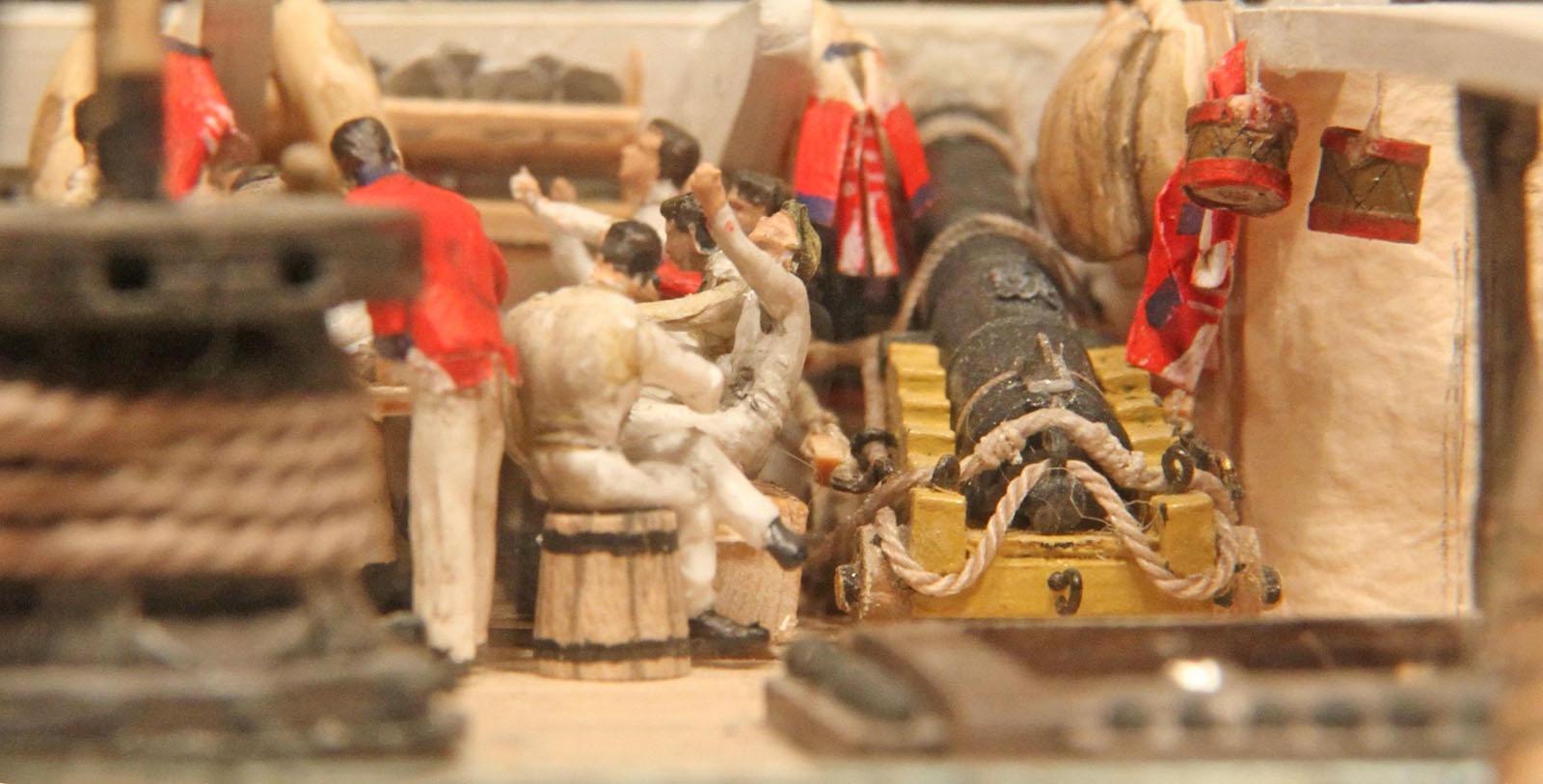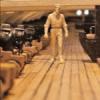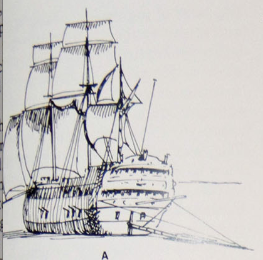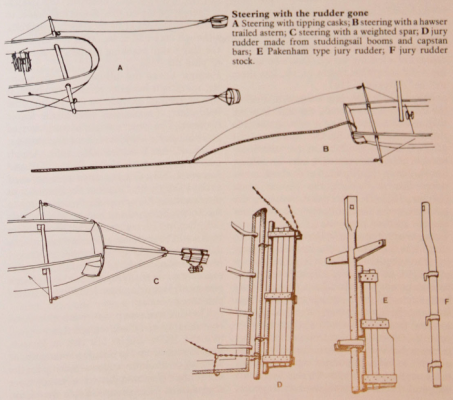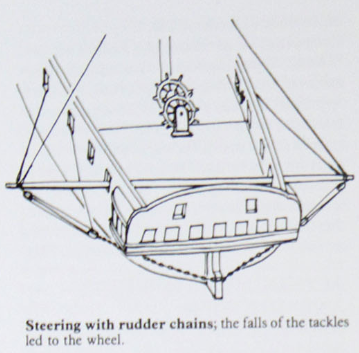-
Posts
2,426 -
Joined
-
Last visited
Content Type
Profiles
Forums
Gallery
Events
Everything posted by dafi
-
Got worried, nice to know you back :-) XXXDAn
- 755 replies
-
- finished
- caldercraft
-
(and 1 more)
Tagged with:
-
Moderators: Is there any possibility to copy this interesting discussion either to Building, Framing, Planking and plating or to Ship's Deck Furniture, Guns, boats and other Fittings. (Good question - is it considered hull or furniture?!?) Like this it we would be jamming this marvelous report and the discussion would be found more easily too :-) If not just delete this message Cheers, Daniel
-
It is simply easier to measure the circumference: Just take a piece of rope and wrap around. For the diameter you need a tool like a caliper. XXXDAn
-
I think Evan summoned the case nicely. The most important was the saving of the rudder. Even though Dave mentions the lock, history is full of broken or lost rudders - another example is the Cutty Sark in race with the Thermopylae, where she lost it in a storm and the need of several days to fix an emergency rudder under these conditions is still one of the great stories of bravery in seamanship. In my understanding the first purpose was to keep the rudder nearby the ship to recover the material. The chain is usually tied close to the stern, keeping the chain out of the water and out of the way and providing by the ties a kind of breaking point to give more line to keep the floating rudder as clear of the hull as possible. Once recovered it for sure was a first option to be used as steering help, but for reasons of lever forces, it was handled by some spars that were set outside as Evan described. This and many more options are nicely shown in the Harland´s Seamanship. Also Nares, Sheet Anchor and Ketch Anchor etc have big sections about replacing the rudder, so it was a well known and especially dangerous issue. Emergency systems contained the use of gun-carriages, barrels, old sails - an interesting and very exciting topic :-) XXXDAn
-
This is common in AOTS and I think it was thought as a mere simplification which results in those stupid errors. AOTS Victory has the same issue - same wrong pattern, all planks exactly 6 meters, split planks in between the coamings and not respecting that the butts should be atop a deck beam. I am even not mentioning that some decks have straight planks, other have curved ones ... XXXDAn
- 4 replies
-
- deck planking
- butt shift
-
(and 1 more)
Tagged with:
-
The loss of the rudder was one of the reasons for the loss of the HMS St. George (1785) at X-Mess 1811 at Thorsminde. http://en.wikipedia.org/wiki/HMS_St_George_(1785) The rudder was found some 200 years later and is in restoration at the museum. Has anybody seen it or has clear pictures? Does it have a turbulence groove? XXXDAn PS: THe german wikipedia is much more detailed: http://de.wikipedia.org/wiki/HMS_St._George_(1785) http://de.wikipedia.org/wiki/HMS_Defence_(1763) Also the museums site is quite interesting: http://www.vragmus.dk/uk-version/marin-arch-uk/rudder.htm http://www.vragmus.dk/uk-version/index-uk.htm see "Photos and find two of the rudder :-) http://www.vragmus.dk/uk-version/marin-arch-uk/methods.htm
-
@foxy, no you wont! Even though using some parts that I produced in my dim and distant past, you already found your own way to make this model your own! Anyway fork and knife or even better Nelson´s knife-fork it is up to you first ;-) Thank you Ian, Mark, Popeye and foxy :-) XXXDan
-
Thanks you Sirs, very kind! My small piece of cake found a temporary home in my Trafalgar shrine, beside the tankard displaying the battle lines, the Nelson magnifying glass, the photography of Nelson´s ghost and the the piece of original oak*** of the HMS Victory. Cheers and shiver in deverence, Daniel ***from ecologically certified dismantling ;-)
-
Wonderful build! A pleasure to see :-) XXXDAn
- 139 replies
-
- corel
- prins willem
-
(and 1 more)
Tagged with:
-
we call it wurstegal* :-) There is Bratwurst**, Bockwurst***, Hanswurst, Wurstwurst and naturally Currywurst. Brockwurst must be one of foxys invention - a hybrid of Brat- and Bockwurst; Sounds promising, I will try and tell you :-) :-) :-) Prost, Daniel * no matter what sausage ** fried sausage *** boiled sausage
-
Perpendicular! :-) XXXDAn
-
Thank you foxy and Mark :-) @mtaylor Do not worry, those are among the most important words to know!!! Prost, Daniel
-
Thank you Ian and Popeye, me too, looking forward for the whole cake ;-) Cheese-chokolate-layers, yummy :-) XXXDAn
-
Alle Jahre wieder (Every year again), also known as "every decade the dafi manages to finish something" ... ... my small slice of in between meal is served ... ... and lives ... ... while you can hear the chant "By the deep 17" ... ... the lieutenant and his midi are listening carefully ... ... and whisper it further with the speaking trumpet. In the same time the crew ... ... with her own calm ... ... and sangfroid ... ... brings up a new rope. And as the story was so great, here the whole picture :-) Now only missing a new passe-partout and some good pictures, cheers, enjoy and have fun, the dafi
-
Here is the picture of the made mast of the Great Britain from Greenwich, nicely seen at least 8 parts. and the Victory with different structure Just one small question: Did the Vasa have made masts? I always believed it to be pole masts. Even the much bigger Victory had pole masts when build in 1765. Cheers, Daniel
-
Love what you are doing and to be honest - you are beyond just using some etch parts, you developed your own style :-) Nicely to be seen on the parts that I did not touch myself! Just one thing - do think twice about using the thinner plastic spars, especially on the bows. Here is a comparison in between the Heller spar and a wooden one of the same diameter. Cheers, Daniel
-
Ian, Foxy, Michael, Hypo, Frank, Mark and Popeye, thank you for your kind words, you are very indulgent :-) It was a fair fight - I got more sausages than Robert - so he HAD to take revenge on the buoy ... ... but to be correct, there is still room for improvement until I do the real thing on my Vic ... ... the two round loops top and bottom should be a tad more towards the middle, the buoy could possibly slide out sideways through the gap in the middle ... ... the knot to fix the buoy rope on the buoy is still to be defined properly. I had to cheat by useing a bowline knot as the bottom eye of the buoy was to small to do two rounds for the intended anchor bend ... ... XXXDAn PS: But hihihihihihihihihi... ... Robert slipped his tongue ... ... he admitted that his model of the french 74 in the Deutsche Museum München has untarred buoy ropes ... ... what a beginner he is ... ...hihihihihihihihi... ;-)- http://www.deutsches-museum.de/en/collections/transport/maritime-exhibition/
-
Thank you all for the kind words :-) By now, this build was incorporated into my big Victory build as it developed into a test for several features over there. Please refer to this link to see the whole documentation full of drama, blood and gore :-) #634 Here some teasers: Cheers, DAniel
-
... ooooh ... ...it still has room for improvement until I do the real thing on my Vic ... ... the two round loops top and bottom should be a tad more towards the middle, the buoy could possibly slide out sideways through the gap in the middle ... ... the knot to fix the buoy rope on the buoy is still to be defined properly. I had to cheat by useing a bowline knot as the bottom eye of the buoy was to small to do two rounds for the intended anchor bend ... ... XXXDAn
About us
Modelshipworld - Advancing Ship Modeling through Research
SSL Secured
Your security is important for us so this Website is SSL-Secured
NRG Mailing Address
Nautical Research Guild
237 South Lincoln Street
Westmont IL, 60559-1917
Model Ship World ® and the MSW logo are Registered Trademarks, and belong to the Nautical Research Guild (United States Patent and Trademark Office: No. 6,929,264 & No. 6,929,274, registered Dec. 20, 2022)
Helpful Links
About the NRG
If you enjoy building ship models that are historically accurate as well as beautiful, then The Nautical Research Guild (NRG) is just right for you.
The Guild is a non-profit educational organization whose mission is to “Advance Ship Modeling Through Research”. We provide support to our members in their efforts to raise the quality of their model ships.
The Nautical Research Guild has published our world-renowned quarterly magazine, The Nautical Research Journal, since 1955. The pages of the Journal are full of articles by accomplished ship modelers who show you how they create those exquisite details on their models, and by maritime historians who show you the correct details to build. The Journal is available in both print and digital editions. Go to the NRG web site (www.thenrg.org) to download a complimentary digital copy of the Journal. The NRG also publishes plan sets, books and compilations of back issues of the Journal and the former Ships in Scale and Model Ship Builder magazines.

